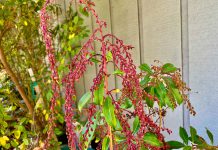|
Dear Editor, This note is in regard to the proposed management of invasive plants on water district property. The sand hills in question are full of precious rare and endangered species, some of which have just a few hundred acres of habitat anywhere in the world. They will be lost without good stewardship. As an environmental professional, I urge everyone in our community to calmly approach this as a technical rather than emotional issue. We all love the environment and want to keep each other safe. I strongly urge the SLVWD Board to shield District staff from political pressure from the concerned and caring environmentalists in our community concerned about Roundup. I urge the Board to direct staff to determine the most efficient and least hazardous integrated pest management approach to conserving biodiversity on the Olympia Wellfield. This is a decision to be made by technical staff, not politics. Further, glyphosate is a standard tool used around the world by conservation organizations and agencies responsible for preserving biodiversity for over 30 years. Staff should evaluate the risk to non-target organisms, water quality, air quality, soil quality, worker safety and the health and safety of watershed residents. After such evaluation, it is likely that they will conclude (or have already concluded) that glyphosate is an appropriate tool in an integrated pest management approach to protect biodiversity. It has low toxicity to organisms other than plants, and the proposed approach of painting on the compound greatly limits impacts to non-target plants. I encourage the District to source the glyphosate from manufacturers other than Monsanto. Bryan Largay, Felton Dear editor: It never ceases to amaze me how multiple witnesses will come away from an event with different stories about what happened. My husband & I were at the Water District meeting on April 20th, and did not hear the same thing Barry Holtzclaw reported on the 21st. Gene Radcliff stated that the board had not yet decided how to proceed with the French Broom issue and that they are open to suggestions. Yet the article says “…district officials gave no indication it planned to replace the herbicide plan”. This is distressing as we all rely on the media to report things fairly & accurately. To avoid any confusion, I am very much against the use of glyphosate anywhere. Let’s keep our minds open as we move forward with this and don’t forget how to listen. Ellen Sweeney, Boulder Creek NOTE: The April 21 edition of the Press Banner was printed on April 19. Dear Editor, There has been much hysteria regarding the SLVWD’s plan to remove invasive French broom, but little consideration of the environment, or the extraordinarily rare sandhill communities that are home to five endangered species and numerous other threatened, endemic and rare species. These fragile communities are located on outcrops of sandy soils that are unique to a few areas of Santa Cruz County. 40% of this habitat is already lost. The “sand parkland” habitat, occurring on fewer than 200 acres in the world must be carefully and actively managed against many threats including recreational use, fire exclusion, and invasive species. The SLVWD’s broom removal supports recommendations in the Sandhills Conservation and Management Plan. The USFWS is ensuring the removal doesn’t impact protected species, and methods also conform to the California Invasive Plant Council’s recommendations for broom management. This plan was therefore developed and informed by peer reviewed studies and the expertise of biologists, botanists, ecologists and other environmental professionals. While the use of herbicide is extremely limited and unlikely to enter our water supply, allowing the broom to continue to invade will surely destroy the sandhill communities as completely as if they were being paved over. Few of us would stand for that. We are a community that prides itself on having informed, progressive attitudes toward the environment, but here we have become prejudiced luddites, willing to lose some of the rarest biological habitats on the planet rather than use a small amount of an herbicide that has been on the market for 40 years. We have higher levels of toxic exposure from things like second hand smoke, pumping gas and doing laundry. This is a choice between a small, temporary local impact versus a shameful and catastrophic permanent impact to our planet’s biodiversity. SLVWD should be commended for efforts to protect this resource. The broom must be destroyed before it goes to seed. The “death of birth” is upon us. Jennifer Gomez, Felton |












